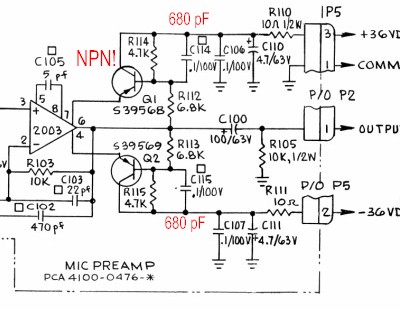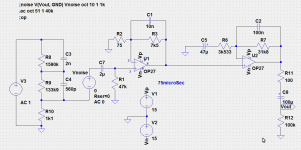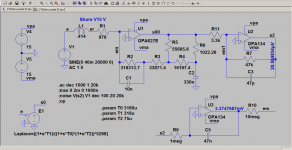All active only uses a single amplifier stage - so it is in fact simpler than active-passive types where you have a gain stage and almost always a buffer. The only 'challenge' with all-active is in doing the network design properly and as you can see from the previous posts, that requires a bit of effort but it's not rocket science.
Not so, it is perfectly possible to use 2 or 3 active amplifier stages, se attachment.
It is even extremely easy to design to within any desired accuracy and also decrease distortion as no amplifier needs to do 56dB+ gain at low frq.
Attachments
Wrt inverting RIAA, there is a noise penalty from the input resistor - no penalty with non inverting.
No noise penalty in the case of inverting current mode RIAA, but you have to optimize for each cartridge.
Not so, it is perfectly possible to use 2 or 3 active amplifier stages, se attachment.
It is even extremely easy to design to within any desired accuracy and also decrease distortion as no amplifier needs to do 56dB+ gain at low frq.
Yes indeed you can make active over two stages - I was just showing in my earlier post that you can use 1 stage and get good performance. If you are using a good opamp, why use two stages = extra noise, complexity etc?
In your split active design, opamp 1 contributes additional noise - that's your trade off since you are boosting the low frequencies in the 2nd stage. If you try to reduce this effect by swapping the stages around, you give up HF headroom in the first stage, but possibly get better overall noise performance. It always pays BTW to try to put the high gain stages first in a signal chain wrt noise performance because the input referred noise of the later stages gets divided by the previous stage gains.
No easy solutions outside of all-active single stage designs I am afraid without tradeoff's!
Last edited:
No noise penalty in the case of inverting current mode RIAA, but you have to optimize for each cartridge.
Yes - agree. I think Erno borbely has done a very good design in LA recently showing this technique with MC. Probably not so easy with MM (Zsource varies significantly over frequency) but I have not tried this. Do you have a design you can share?
Yes - agree. I think Erno borbely has done a very good design in LA recently showing this technique with MC. Probably not so easy with MM (Zsource varies significantly over frequency) but I have not tried this. Do you have a design you can share?
I made this one which I still have to optimize : you have to include the low pass formed by resistor and self of the cartridge in the response.
Attachments
Yes indeed you can make active over two stages - I was just showing in my earlier post that you can use 1 stage and get good performance. If you are using a good opamp, why use two stages = extra noise, complexity etc?
You don't necessarily get lower noise with 1 opamp vs 2 or 3. Complexity within reason is not an issue nor a goal in itself. You can't hear lack of complexity. Designed correctly, you can get quite good results with lesser opamps. LM833 comes to mind - it is less noisy than NE5532 at very low impedances and for the price of one LM4562 you get 7 LM833, for basically the same noise performance.
Mostly we are told that there are two issues with respect to designing good RIAA amps: Noise and headroom. I think that also distortion, complexity, price are important issues, the latter specially if you are a producer.
,In your split active design, opamp 1 contributes additional noise - that's your trade off since you are boosting the low frequencies in the 2nd stage. If you try to reduce this effect by swapping the stages around, you give up HF headroom in the first stage
Yes!
...but possibly get better overall noise performance.
No. On the contrary.
On the bottom line, if all the noise sources of a design is significantly below the noise of the cartridge, then improving your design (noise-wise) is going be of little consequence.
No easy solutions outside of all-active single stage designs I am afraid without tradeoff's!
Who said it should be easy ? Besides, I think a 2 opamp design is much easier.
I think another concept that should be explored in Douglas' book is vinyl streaming.
Flat Preamp > A/D > DSP-Declick > DSP RIAA > Stream
I have quite a few customers doing this.
Flat Preamp > A/D > DSP-Declick > DSP RIAA > Stream
I have quite a few customers doing this.
One idea I rather like although had no sucess with was a voltage rail boosted op amp. My feeling is that overload margins for phono stages is all imagined. A little thought about how a pick up works and it's damping would suggest it's like a Spitfire going supersonic ( The Soviet Bear TU-95 is a study in that as it exceeds what was thought possible ). I have tested this to crazy limits and found at worse the distortions of a good valve record player.
The conjecture is if we took a fantastic op amp that would allow boosted voltage rails I know in my heart the rails would never be used, thus do no harm. For people who insist passive EQ and op amps won't work it might keep them happy to look at it. I possibly would use 75uS passive with gain ( 5 to 60 to allow MM/MC ) followed by active 3180/318us with gain of 20 at 1 kHz. Then a 2uS pasive output filter. I don't suggest the circuit in the link is used. It is an example of how simple it could be.
http://joebrown.org.uk/images/DualPSU/BootstrappingOpAmps.pdf
The conjecture is if we took a fantastic op amp that would allow boosted voltage rails I know in my heart the rails would never be used, thus do no harm. For people who insist passive EQ and op amps won't work it might keep them happy to look at it. I possibly would use 75uS passive with gain ( 5 to 60 to allow MM/MC ) followed by active 3180/318us with gain of 20 at 1 kHz. Then a 2uS pasive output filter. I don't suggest the circuit in the link is used. It is an example of how simple it could be.
http://joebrown.org.uk/images/DualPSU/BootstrappingOpAmps.pdf
Silly rule really as it is completely aimed at here and was refered to by an other. In my work we have safety rules. They I respect.
It begs a question. How did someone in the past post something twice and the world of here fell apart. BTW they are not identical. I did it because I am time poor today and really hoped somone out there has done this. Once in a blue moon some have actually gone forward at DIY. I saw it once with two pole VAS cDom that involved the output devices. I did it and my goodness it worked. Mostly because I insist in using MOS FET's I needed to ( 50 kHz clean up ). It was the largest free lunch ever I saw. Yes, test gear was used. It was surprisingly stable. Sorry guys it is rare we get this. No one seemed very excited about. Crazy.
It begs a question. How did someone in the past post something twice and the world of here fell apart. BTW they are not identical. I did it because I am time poor today and really hoped somone out there has done this. Once in a blue moon some have actually gone forward at DIY. I saw it once with two pole VAS cDom that involved the output devices. I did it and my goodness it worked. Mostly because I insist in using MOS FET's I needed to ( 50 kHz clean up ). It was the largest free lunch ever I saw. Yes, test gear was used. It was surprisingly stable. Sorry guys it is rare we get this. No one seemed very excited about. Crazy.
There's no doubt passive-active, active-passive or active-active work - there are plenty of examples around that attest to that. I think the statement that's been made by the single active stage proponents is that there are tradeoff's with these approaches that do not exist with single stage all active designs.
Here's an example of a boosted rail 5534 ("2003") used in MCI consoles.
Note that there is an error in this drawing: Q1 is NPN.

MCI "Swinging Op Amp" Voltage-Boosted NE5534
Note that there is an error in this drawing: Q1 is NPN.

MCI "Swinging Op Amp" Voltage-Boosted NE5534
C114-R114-R112 seem to make the "boosting" feature operate only at frequencies below 570 Hertz. Higher than that, Q1's base is shorted to AC ground via C114. Why is this good?
Last edited:
That might be an error too. Not my drawing.
EDIT: That IS a drafting error. In the JH-500C they are 680 pF.
I've used that circuit with far lower values of capacitance.
As a general concept and headroom extender it works OK.
MCI used it first in the 500-series console in the EQ section to replace the HA-2645 HV op amp. If I can find a schematic I'll look and see what C values they used.
By posting this it does not mean I think boosted rails are necessarily a good or bad idea in a phono preamp. Simply a point of reference for a 40 year-old circuit...
EDIT: That IS a drafting error. In the JH-500C they are 680 pF.
I've used that circuit with far lower values of capacitance.
As a general concept and headroom extender it works OK.
MCI used it first in the 500-series console in the EQ section to replace the HA-2645 HV op amp. If I can find a schematic I'll look and see what C values they used.
By posting this it does not mean I think boosted rails are necessarily a good or bad idea in a phono preamp. Simply a point of reference for a 40 year-old circuit...
Last edited:
Here's a corrected copy from the JH-500C mic preamp. The Cs are 680 pF.
The 0.1 uF rail bypass are nearby.
Their proximity in the drawing obviously must have confused the draftsman in the JH-600 schematic.
Not surprising since he got Q1 wrong too.
Good catch. 680 pF moves it to about 87 kHz.

The 0.1 uF rail bypass are nearby.
Their proximity in the drawing obviously must have confused the draftsman in the JH-600 schematic.
Not surprising since he got Q1 wrong too.
Good catch. 680 pF moves it to about 87 kHz.

Last edited:
As they say nothing new under the Sun. I am very busy at this moment. When the time is right I will build something. All I hope is it is no worse than my usual circuit with a bit more headroom for the belivers. Thank you for posting it.
I will also spend time looking at vidoe op amps as I feel they offer something for an all active preamp. I found a SMD type years ago that showed good 20 Hz to 20 kHz noise spec and said also for audio use. Sorry to say I forgot to note it's number ( LT I think ). 0.9nV and - 86dB THD come to mind as it's spec. Some video op amps only come good above the audio band. One I saw the other day had open loop gain up to 3 MHz before falling ( 450 MHz GBP ). The THD graphs look excellent when seeing the 3 rd harmonic. I guess in video 3rd would be something that could fire up RF problems. Very helpful to see it and rather remarkable.
Douglas did the class AC amplifier which was the only time I can remember his books going slightly in the horrible idea direction. It was very good fun and good science. I would love the idea of a boosted op amp and all active to be in the book and see where we can go. This op amp should be a good starting point. I would hope for state of the art overload margin for the hell of it. The turbocharger in mechanical engineering is respected, it can boost economy. The fun is trying to tune out it's known problems.
If a I post a duplicate again I will rewrite it to stay inside the rules.
http://cds.linear.com/docs/en/datasheet/lt1115fa.pdf
I will also spend time looking at vidoe op amps as I feel they offer something for an all active preamp. I found a SMD type years ago that showed good 20 Hz to 20 kHz noise spec and said also for audio use. Sorry to say I forgot to note it's number ( LT I think ). 0.9nV and - 86dB THD come to mind as it's spec. Some video op amps only come good above the audio band. One I saw the other day had open loop gain up to 3 MHz before falling ( 450 MHz GBP ). The THD graphs look excellent when seeing the 3 rd harmonic. I guess in video 3rd would be something that could fire up RF problems. Very helpful to see it and rather remarkable.
Douglas did the class AC amplifier which was the only time I can remember his books going slightly in the horrible idea direction. It was very good fun and good science. I would love the idea of a boosted op amp and all active to be in the book and see where we can go. This op amp should be a good starting point. I would hope for state of the art overload margin for the hell of it. The turbocharger in mechanical engineering is respected, it can boost economy. The fun is trying to tune out it's known problems.
If a I post a duplicate again I will rewrite it to stay inside the rules.
http://cds.linear.com/docs/en/datasheet/lt1115fa.pdf
sub nV BJT input op amps may be OK for MC, will give worse noise with most MM than a lower input current noise FET
and I do question some of the "dynamic range" arguments - some characterize "pop" as low frequency, even exciting tone arm resonance - which implies a deep scratch or crater that has destroyed the audio anyway
the low frequency content is amplified more per the RIAA curve
while "ticks" look like small amplitude high frequency deltas after eq
so it seems a discussion needs examples of real world legitimate audio signal amplitude vs frequency from the cartridge and the same for expected errors ranging from surface noise to mistracking, to damaged record groove
and a philosophy of what a preamp should do with error "signals" from the cartridge that are in no way audio
I really don't see extended V swing, boosted or bootstrapped preamps just to linearly amplify non-audio errors of damaged record playback
and I do question some of the "dynamic range" arguments - some characterize "pop" as low frequency, even exciting tone arm resonance - which implies a deep scratch or crater that has destroyed the audio anyway
the low frequency content is amplified more per the RIAA curve
while "ticks" look like small amplitude high frequency deltas after eq
so it seems a discussion needs examples of real world legitimate audio signal amplitude vs frequency from the cartridge and the same for expected errors ranging from surface noise to mistracking, to damaged record groove
and a philosophy of what a preamp should do with error "signals" from the cartridge that are in no way audio
I really don't see extended V swing, boosted or bootstrapped preamps just to linearly amplify non-audio errors of damaged record playback
I really don't see extended V swing, boosted or bootstrapped preamps just to linearly amplify non-audio errors of damaged record playback
Not in itself, I agree, but such a non-audio error might clip or overdrive the amp and thereby block the audio itself. Maybe that in itself is a good reason for stratospheric headroom?
Jan
- Home
- Source & Line
- Analogue Source
- What would you want to see in a book on electronics for vinyl replay? Douglas Self.

